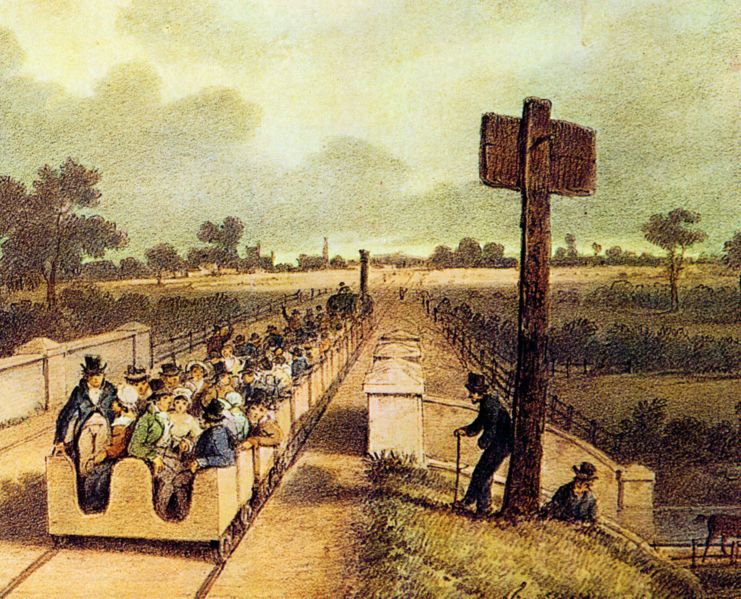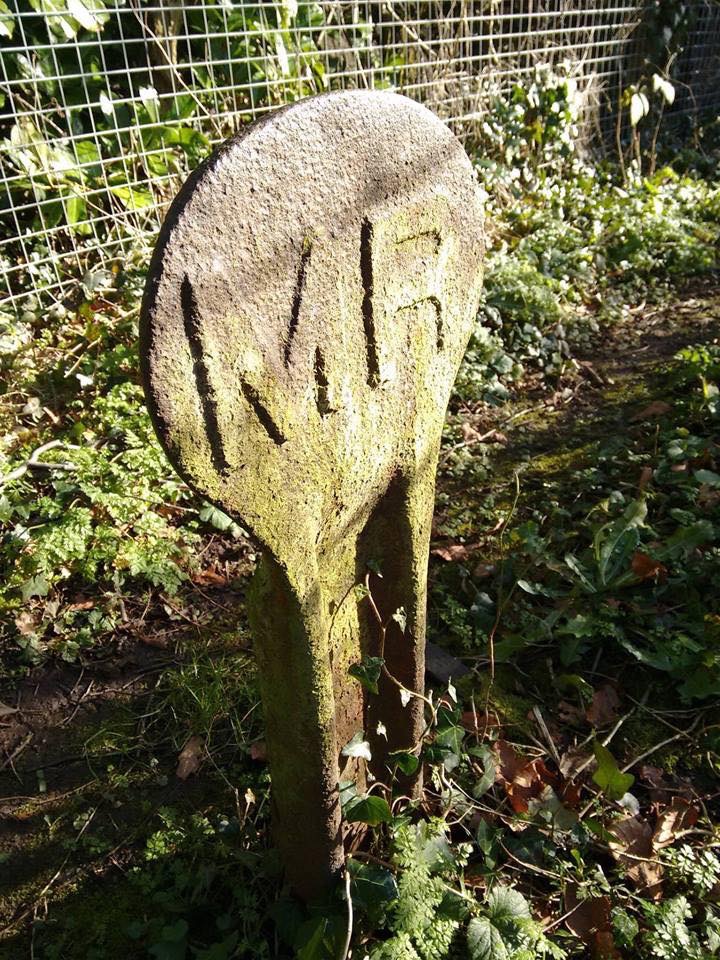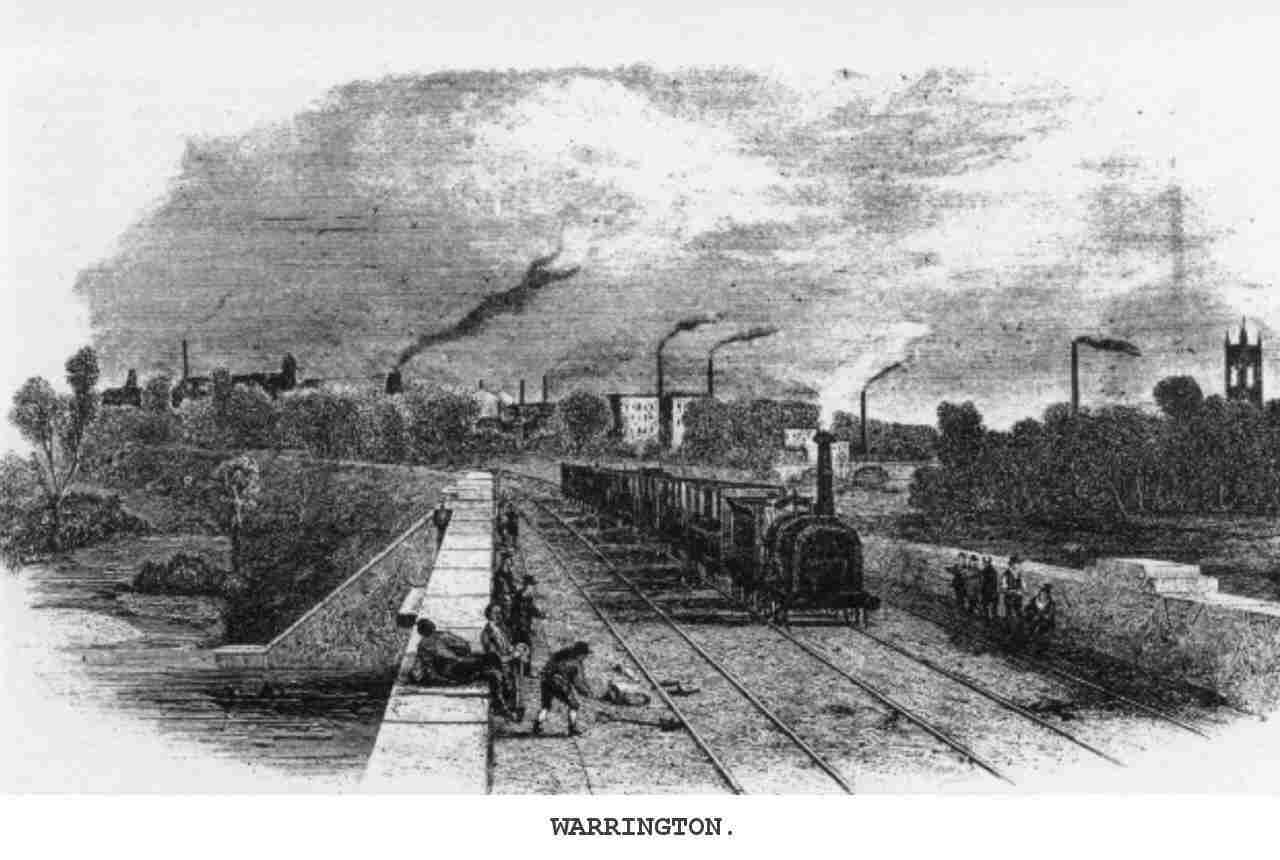|
History Of Rail Transport In Great Britain 1830–1922
The history of rail transport in Great Britain 1830–1922 covers the period between the opening of the Liverpool and Manchester Railway (L&MR), and the Grouping, the amalgamation of almost all of Britain's many railway companies into the Big Four by the Railways Act 1921. The 1830s As Manchester had grown on cotton spinning, so Leeds had a growing trade in weaving. The Pennines restricted canal development, so the railway provided a realistic alternative, especially with the growth in coal usage from the mines in the North East and Yorkshire. A number of lines were approved in the area, such as the Leeds and Selby Railway, in 1830, which would link the former to the port of Hull, via the River Ouse. While the L&MR had not ousted the Lancashire canal system from the transport of goods, there was an unexpected enthusiasm for passenger travel. The financial success of these lines was beyond all expectations, and interests in London and Birmingham soon planned to build lines ... [...More Info...] [...Related Items...] OR: [Wikipedia] [Google] [Baidu] |
History Of Rail Transport In Great Britain To 1830
The history of rail transport in Great Britain to 1830 covers the period up to the opening of the Liverpool and Manchester Railway, the world's first intercity passenger railway operated solely by steam locomotives. The earliest form of railways, horse-drawn wagonways, originated in Germany in the 16th century. Soon wagonways were also built in Britain. However, the first use of steam locomotives was in Wales. The invention of wrought iron rails, together with Richard Trevithick's pioneering steam locomotive meant that Britain had the first modern railways in the world. Early rails A wagonway was used by German miners at Caldbeck, Cumbria, England, perhaps from the 1560s. A wagonway was built at Prescot, near Liverpool, sometime around 1600, possibly as early as 1594. Owned by Philip Layton, the line carried coal from a pit near Prescot Hall to a terminus about half a mile away. Another wagonway was Sir Francis Willoughby's Wollaton Wagonway in Nottinghamshire built between ... [...More Info...] [...Related Items...] OR: [Wikipedia] [Google] [Baidu] |
Grand Junction Railway
The Grand Junction Railway (GJR) was an early railway company in the United Kingdom, which existed between 1833 and 1846. The line built by the company, which opened in 1837, linked the Liverpool and Manchester Railway to Birmingham via Warrington, Crewe, Stafford and Wolverhampton. This was the first trunk railway to be completed in England, and arguably the world's first long-distance railway with steam traction. It terminated at Birmingham Curzon Street railway station (1838–1966), Curzon Street Station in Birmingham, which it shared with the London and Birmingham Railway (L&BR), whose adjacent platforms gave an interchange with full connectivity (with through carriages) between Liverpool, Manchester and London. The company merged with its business partners in 1846 to form the London and North Western Railway (LNWR). The lines which comprised the GJR now form the central section of the West Coast Main Line. History The Grand Junction Railway Company was established in ... [...More Info...] [...Related Items...] OR: [Wikipedia] [Google] [Baidu] |
Midland Railway
The Midland Railway (MR) was a railway company in the United Kingdom from 1844 in rail transport, 1844. The Midland was one of the largest railway companies in Britain in the early 20th century, and the largest employer in Derby, where it had its headquarters. It amalgamated with several other railways to create the London, Midland and Scottish Railway at Railways Act 1921, grouping in 1923. The Midland had a large network of lines emanating from Derby, stretching to St Pancras railway station, London St Pancras, Manchester Central railway station, Manchester, Carlisle railway station, Carlisle, Birmingham Curzon Street railway station (1838–1966), Birmingham, and Bristol Temple Meads railway station, Bristol. It expanded as much through acquisitions as by building its own lines. It also operated ships from Heysham in Lancashire to Douglas, Isle of Man, Douglas and Belfast. A large amount of the Midland's infrastructure remains in use and visible, such as the Midland Main Lin ... [...More Info...] [...Related Items...] OR: [Wikipedia] [Google] [Baidu] |
Eastern Counties Railway
The Eastern Counties Railway (ECR) was an English railway company incorporated in 1836 intended to link London with Ipswich via Colchester, and then extend to Norwich and Yarmouth. Construction began in 1837 on the first at the London end. Construction was beset by engineering and other problems, leading to severe financial difficulties. As a result, the project was truncated at Colchester in 1843 but through a series of acquisitions (including the Eastern Union Railway who completed the link between Colchester and Norwich) and opening of other lines, the ECR became the largest of the East Anglian railways. In 1862 ECR was merged with a number of other companies to form the Great Eastern Railway. Opening In 1835, a surveyor called Henry Sayer presented a plan for a new railway from London to York via Cambridge to London solicitors Dimes & Boyman. Together with John Clinton Robertson who was to become the first secretary of the ECR and engineers John Braithwaite it was concl ... [...More Info...] [...Related Items...] OR: [Wikipedia] [Google] [Baidu] |
Railway Clearing House
The Railway Clearing House (RCH) was an organisation set up to manage the allocation of revenue collected by Railways Act 1921, pre-grouping railway companies for the conveyance of passengers and goods over the lines (or using the rolling stock) of other companies. It went on to become the major regulatory body overseeing the day-to-day running of railways in Great Britain and setting common standards for railway companies, which ensured their safety and interoperability. The RCH also produced fare structures governing many aspects of rail transport at a national level and set limits on price increases for passenger travel. Rationale When passengers travelled between two stations on the same railway, using trains provided by the same company, that company was entitled to the whole of the fare. Similarly, when goods were consigned between two stations on the same railway, using wagons provided by the same company, that company was entitled to the whole of the fee. However, when c ... [...More Info...] [...Related Items...] OR: [Wikipedia] [Google] [Baidu] |
George Hudson
George Hudson (probably 10 March 1800 – 14 December 1871) was an English railway financier and politician who, because he controlled a significant part of the Railway Mania, railway network in the 1840s, became known as "The Railway King"—a title conferred on him by Sydney Smith in 1844. Hudson played a significant role in linking London to Edinburgh by rail, carrying out the first major merging of railway companies (the Midland Railway) and developing his home city of York into a major railway junction. He also represented Sunderland (UK Parliament constituency), Sunderland in the House of Commons of the United Kingdom, House of Commons. Hudson's success was built on dubious financial practices and he frequently paid shareholders out of capital rather than money the company had earned. Eventually in 1849, a series of enquiries, launched by the railways he was chairman of, exposed his methods, although many leading the enquiries had benefited from and approved of Hudson's m ... [...More Info...] [...Related Items...] OR: [Wikipedia] [Google] [Baidu] |
Derby Midland Railway Station
Derby railway station (, also known as Derby Midland) is a main line railway station serving the city of Derby in Derbyshire, England. Owned by Network Rail and managed by East Midlands Railway, the station is also served by CrossCountry services. It is the busiest station in Derbyshire, and the third busiest station in the East Midlands. It lies north of London St Pancras. It is situated to the south-east of Derby city centre, and is close to the west bank of the River Derwent. Overview The decision by the Midland Railway to have its headquarters in Derby made the town a busy node of the rail network. First opened in 1839, it was at the time one of the largest stations in the country, and was unusual for being shared by more than one company. Until its closure in 1990, Derby Railway Works, consisting of major carriage and locomotive workshops, as well as the Research Division in the Railway Technical Centre were housed there. The station is an interchange point between ... [...More Info...] [...Related Items...] OR: [Wikipedia] [Google] [Baidu] |
George Hudson - Project Gutenberg EText 17293
George may refer to: Names * George (given name) * George (surname) People * George (singer), American-Canadian singer George Nozuka, known by the mononym George * George Papagheorghe, also known as Jorge / GEØRGE * George, stage name of Giorgio Moroder * George, son of Andrew I of Hungary Places South Africa * George, South Africa, a city ** George Airport United States * George, Iowa, a city * George, Missouri, a ghost town * George, Washington, a city * George County, Mississippi * George Air Force Base, a former U.S. Air Force base located in California Computing * George (algebraic compiler) also known as 'Laning and Zierler system', an algebraic compiler by Laning and Zierler in 1952 * GEORGE (computer), early computer built by Argonne National Laboratory in 1957 * GEORGE (operating system), a range of operating systems (George 1–4) for the ICT 1900 range of computers in the 1960s * GEORGE (programming language), an autocode system invented by Charles Leonard Hambli ... [...More Info...] [...Related Items...] OR: [Wikipedia] [Google] [Baidu] |
Advanced Passenger Train
The Advanced Passenger Train (APT) was a tilting high speed train developed by British Rail during the 1970s and early 1980s, for use on the West Coast Main Line (WCML). The WCML contains many curves, and the APT pioneered the concept of active tilting to address these, a feature that has since been copied on designs around the world. The experimental APT-E achieved a new British railway speed record on 10 August 1975 when it reached , only to be surpassed by the service prototype APT-P at in December 1979. Development of the service prototypes progressed slowly, and by the late 1970s the design had been under construction for a decade and the trains were still not ready for service. The election of Margaret Thatcher brought matters to a head and she alluded to funding cuts for the project. Facing the possibility of cancellation, BR management decided to put the prototypes into service, with the first runs along the London–Glasgow route taking place in December 1981. The p ... [...More Info...] [...Related Items...] OR: [Wikipedia] [Google] [Baidu] |
British Rail
British Railways (BR), which from 1965 traded as British Rail, was a state-owned company that operated most rail transport in Great Britain from 1948 to 1997. Originally a trading brand of the Railway Executive of the British Transport Commission, it became an independent statutory corporation in January 1963, when it was formally renamed the British Railways Board. British Railways was formed on 1 January 1948 as a result of the Transport Act 1947, which nationalised the Big Four British railway companies along with some other (but not all) smaller railways. Profitability of the railways became a pressing concern during the 1950s, leading to multiple efforts to bolster performance, including some line closures. The 1955 Modernisation Plan formally directed a process of dieselisation and electrification to take place; accordingly, steam locomotives had been entirely replaced by diesel and electric traction (except for the narrow-gauge Vale of Rheidol Railway tourist lin ... [...More Info...] [...Related Items...] OR: [Wikipedia] [Google] [Baidu] |
Right-of-way (transportation)
A right of way (also right-of-way) is a specific route that people, animals, vehicles, watercraft, or utility lines travel, or the legal status that gives them the right to do so. Rights-of-way in the physical sense include controlled-access highways, railroads, canals, hiking paths, bridle paths for horses, bicycle paths, the routes taken by high-voltage lines (also known as wayleave), utility tunnels, or simply the paved or unpaved local roads used by different types of traffic. The term ''highway'' is often used in legal contexts in the sense of "main way" to mean any public-use road or any public-use road or path. Some are restricted as to mode of use (for example, pedestrians only, pedestrians, horse and cycle riders, vehicles capable of a minimum speed). Rights-of-way in the legal sense (the right to pass through or to operate a transportation facility) can be created in a number of different ways. In some cases, a government, transportation company, or conservation n ... [...More Info...] [...Related Items...] OR: [Wikipedia] [Google] [Baidu] |
Warrington
Warrington () is an industrial town in the Borough of Warrington, borough of the same name in Cheshire, England. The town sits on the banks of the River Mersey and was Historic counties of England, historically part of Lancashire. It is east of Liverpool and the same distance west of Manchester. The population in 2021 was recorded as 174,970 for the built-up area and 210,900 for the wider borough, the latter being more than double that of 1968 when it became a New towns in the United Kingdom, new town. Warrington is the largest town in the ceremonial county of Cheshire. Warrington was founded by the Roman Britain, Romans at an important crossing place on the River Mersey. A new settlement was established by the Saxons, Saxon Wærings. By the Middle Ages, Warrington had emerged as a market town at the lowest bridging point of the river. A local tradition of textile and tool production dates from this time. The expansion and urbanisation of Warrington coincided with the Industr ... [...More Info...] [...Related Items...] OR: [Wikipedia] [Google] [Baidu] |







